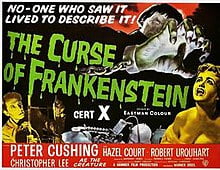“Unleashing Horror’s Finest: ‘The Curse of Frankenstein’ (1957) – A Timeless Classic or a Monster Misfire?”
PLEASE TRY NOT TO FAINT. Not recommended for people of nervous disposition.
“The Curse of Frankenstein” (1957) reimagines Mary Shelley’s classic tale with vibrant color, striking visuals, and a chilling performance by Peter Cushing as the morally ambiguous Dr. Victor Frankenstein, ushering in a new era of horror cinema.
“The Curse of Frankenstein” (1957) stands as a landmark achievement in horror cinema, revolutionizing the genre and setting the stage for a new era of frights and thrills. Directed by Terence Fisher and produced by Hammer Film Productions, this iconic adaptation of Mary Shelley’s classic novel breathes new life into the tale of Dr. Frankenstein and his monstrous creation, delivering a gripping and atmospheric experience that continues to captivate audiences to this day.
At its core, “The Curse of Frankenstein” is a tale of ambition, obsession, and the consequences of playing god. Peter Cushing delivers a tour-de-force performance as the brilliant yet morally ambiguous Dr. Victor Frankenstein, whose relentless pursuit of scientific discovery leads him down a dark and dangerous path. Paired with Christopher Lee’s imposing presence as the Creature, the film explores themes of identity, morality, and the horrors that lurk within the human soul.
What truly sets “The Curse of Frankenstein” apart is its bold and innovative approach to storytelling. In an era dominated by black-and-white classics, Hammer Films dared to inject vibrant color and visceral violence into the horror genre, creating a visual style that was both striking and memorable. From the lavish sets and costumes to the gruesome makeup effects that bring the Creature to life, every frame is a testament to the filmmakers’ commitment to pushing boundaries and defying expectations.
Furthermore, the film’s atmospheric cinematography and evocative score contribute to its sense of dread and unease, drawing viewers into a world of gothic splendor and creeping horror. Terence Fisher’s masterful direction infuses each scene with tension and suspense, building to a climactic showdown that leaves audiences on the edge of their seats. It’s a testament to the enduring power of classic horror, proving that true terror is timeless.
However, “The Curse of Frankenstein” is not without its flaws. Some viewers may find the pacing slow by modern standards, with long stretches of exposition interrupting the action. Additionally, while Peter Cushing and Christopher Lee deliver standout performances, the supporting cast can feel underdeveloped, with characters serving primarily as foils for the leads. Yet, these minor shortcomings do little to detract from the film’s overall impact and enduring legacy.
In conclusion, “The Curse of Frankenstein” remains a cornerstone of horror cinema, a timeless classic that continues to inspire and terrify audiences more than six decades after its release. With its unforgettable performances, stunning visuals, and thought-provoking themes, it’s a must-see for any fan of the genre. So embrace the darkness, and prepare to be spellbound by the chilling tale of Dr. Frankenstein and the curse that haunts him – you won’t be disappointed.

Cast
The cast of “The Curse of Frankenstein” (1957) includes:
- Peter Cushing as Baron Victor Frankenstein
- Christopher Lee as the Creature
- Hazel Court as Elizabeth
- Robert Urquhart as Paul Krempe
- Melvyn Hayes as Young Victor
- Valerie Gaunt as Justine
- Paul Hardtmuth as Professor Bernstein
- Noel Hood as Aunt Sophia
- Fred Johnson as Grandpa
- Claude Kingston as the Burgomaster
These talented actors bring the iconic characters of Mary Shelley’s novel to life in Hammer Films’ reimagining of the classic tale, contributing to the film’s enduring legacy in the horror genre.

 Buy me a coffee
Buy me a coffee